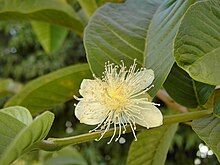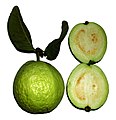Guava
| Guava | |
|---|---|

| |
| Apple guava (Psidium guajava) | |
| Scientific classification | |
| Kingdom: | |
| (unranked): | |
| (unranked): | |
| (unranked): | |
| Order: | |
| Family: | |
| Subfamily: | |
| Genus: | Psidium |
| Species | |
|
About 100, see text. | |
Guava is a genus of about 100 species of tropical shrubs and small trees in the myrtle family Myrtaceae. Native to Mexico and Central America, northern South America, parts of the Caribbean and some parts of North Africa, it is now cultivated throughout the tropics. Numerous references in medical research identify guava as Psidium guajava.
They are typical Myrtoideae, with tough dark leaves that are opposite, simple, elliptic to ovate and 5-15 cm long. The flowers are white, with five petals and numerous stamens.
In several tropical regions, including Hawaii, some species (namely Cattley guava a.k.a. strawberry guava, P. littorale) have become invasive weed shrubs. On the other hand, several species have become very rare and at least one (Jamaican guava, P. dumetorum), is already extinct.
The genera Accara and Feijoa (= Acca, pineapple guava) were formerly included.
Etymology
The name appears to derive from Arawak via Spanish, guayaba. In Hindi as well as Urdu, guava are called amrood, in Marathi peru, in Sri Lanka pera, in Telugu jaama (జామ), in Bengali peyara (পেয়ারা) and in Tagalog bayabas, probably a local rendition of guayaba.
Cultivation
Guavas are cultivated in many tropical and subtropical countries for their edible fruit. Several species are grown commercially; apple guava (P. guajava) and its cultivars are those most commonly traded internationally.
Mature trees of most species are fairly cold-hardy and can survive as low as 5°C for short periods of time, but younger plants will not survive. They are known to survive in Northern Pakistan where they can get down to 5°C or lower during the night. Guavas are also of interest to home growers in temperate areas, being one of the very few tropical fruits that can be grown to fruiting size in pots indoors.
Culinary uses and peel nutrients
The guava fruit is edible, round to pear-shaped, from 3-10 cm in diameter (up to 12 cm in some selected cultivars). It has a thin delicate rind, pale green to yellow at maturity in some species, pink to red in others, a creamy white or orange-salmon flesh with many small hard seeds, and a strong, characteristic aroma that is hard to describe but generally reminiscent of refreshing fruit like apples, passionfruit or strawberries, with an inoffensive acidity and a fragrance reminiscent of rose petals.
The whole fruit is edible, from seeds to rind, but many people choose to cut out the middle which contains hard seeds embedded in the surrounding pulp. The pulp is sweetest in the center, with the outer layer being sour and gritty like young pears, while the peel is sour in taste but richest in phytochemicals; it is usually discarded but can be eaten as an enriched source of polyphenols and essential nutrients, especially an exceptional content of dietary fiber.[1]
The fruit is also often prepared as a dessert. In Asia, fresh raw guava is often dipped in preserved prune powder or salt. Boiled guava is also extensively used to make candies, preserves, jellies, jams, marmalades (goiabada), juices and aguas frescas. In Asia, a tea is made from guava fruits and leaves. Guava juice is very popular in Mexico, Egypt and South Africa. Red guavas can be used as the base of salted products such as sauces, constituting a substitute for tomatoes, especially for those sensitive to the latter's acidity.
Guava wood is used for meat smoking in Hawaii and competition barbecue.
Psidium species are used as food plants by the caterpillars of some Lepidoptera, mainly moths like the Ello Sphinx (Erinnyis ello), Eupseudosoma aberrans, Snowy Eupseudosoma (E. involutum)and Hypercompe icasia. Mites like Pronematus pruni and Tydeus munsteri are known to parasitize Apple Guava (P. guabaya) and perhaps other species. The bacterium Erwinia psidii causes rot diseases of the Apple Guava.
The fruit are also relished by many mammals and birds. The spread of introduced guavas owes much to this fact, as animals will eat the fruit and disperse the seeds in their droppings.
Nutrients and dietary antioxidant value
Guavas are often considered superfruits, being rich in vitamins A and C, omega-3 and -6 polyunsaturated fatty acids (mainly in the seeds which must be chewed to obtain the omega fats) and especially high levels of dietary fiber. A single Guava contains over four times the amount of vitamin C as a single orange (228mg per 100g serving), and also has good levels of the dietary minerals, potassium, magnesium, and an otherwise broad, low-calorie profile of essential nutrients. However, nutritional value is greatly dependent on type, the strawberry guava notably contains only 37mg of vitamin C per 100g serving, practically a tenth of the vitamin C found in more common varieties.[2]
Guavas contain both major classes of antioxidant pigments -- carotenoids and polyphenols, giving them relatively high dietary antioxidant value among plant foods.[3][4][5] As pigments provide plant food their colors, guavas that are red, yellow or orange in color have more potential value as antioxidants sources than unpigmented species.[6]
| Food Value Per 100 g of Edible Portion | |
|---|---|
| Calories | 36-50 |
| Moisture | 77-86 g |
| Crude Fiber | 2.8-5.5 g |
| Protein | 0.9-1.0 g |
| Fat | 0.1-0.5 g |
| Ash | 0.43-0.7 g |
| Carbohydrates | 9.5-10 g |
| Calcium | 9.1-17 mg |
| Phosphorus | 17.8-30 mg |
| Iron | 0.30-0.70 mg |
| Carotene (Vitamin A) | 200-400 I.U |
| Thiamine | 0.046 mg |
| Riboflavin | 0.03-0.04 mg |
| Niacin | 0.6-1.068 mg |
| Vitamin B3 | 40 I.U. |
Medical research
Since the 1950s, guava, particularly its leaves, has been a subject for diverse research in chemical identity of its constituents, pharmacological properties and history in folk medicine.[7] For example, from preliminary medical research in laboratory models, extracts from guava leaves or bark are implicated in therapeutic mechanisms against cancer, bacterial infections, inflammation and pain.[8][9][10] Essential oils from guava leaves have shown strong anti-cancer activity in vitro.[11]
Folk medicine applications
Guava leaves are used as a remedy for diarrhea[12] and for their supposed antimicrobial properties. Guava leaves or bark have been used traditionally to treat diabetes.[13][14]
Selected species

|
|
-
'Thai Maroon' guavas
-
Green guavas
-
Ripe guavas
-
Indonesian guavas
-
Apple guavas
See also
- Leslie R. Landrum, guava botanist
Footnotes
- ^ Jiménez-Escrig A, Rincón M, Pulido R, Saura-Calixto F. Guava fruit (Psidium guajava L.) as a new source of antioxidant dietary fiber. J Agric Food Chem. 2001 Nov;49(11):5489-93.
- ^ Nutrient facts comparison for common guava, strawberry guava, and oranges.[1]
- ^ Mahattanatawee K, Manthey JA, Luzio G, Talcott ST, Goodner K, Baldwin EA. Total antioxidant activity and fiber content of select Florida-grown tropical fruits. J Agric Food Chem. 2006 Sep 20;54(19):7355-63. [2]
- ^ Hassimotto NM, Genovese MI, Lajolo FM. Antioxidant activity of dietary fruits, vegetables, and commercial frozen fruit pulp. J Agric Food Chem. 2005 Apr 20;53(8):2928-35.
- ^ Jiménez-Escrig A, Rincón M, Pulido R, Saura-Calixto F. Guava fruit (Psidium guajava L.) as a new source of antioxidant dietary fiber. J Agric Food Chem. 2001 Nov;49(11):5489-93.[3]
- ^ Wrolstad R. The possible health benefits of anthocyanin pigments and polyphenolics, Linus Pauling Institute, 2001
- ^ Gutiérrez RM, Mitchell S, Solis RV. Psidium guajava: A review of its traditional uses, phytochemistry and pharmacology. J Ethnopharmacol. 2008 Feb 3[4]
- ^ Chen KC, Hsieh CL, Peng CC, Hsieh-Li HM, Chiang HS, Huang KD, Peng RY. Brain derived metastatic prostate cancer DU-145 cells are effectively inhibited in vitro by guava (Psidium gujava L.) leaf extracts. Nutr Cancer. 2007;58(1):93-106.[5]
- ^ Mahfuzul Hoque MD, Bari ML, Inatsu Y, Juneja VK, Kawamoto S. Antibacterial activity of guava (Psidium guajava L.) and Neem (Azadirachta indica A. Juss.) extracts against foodborne pathogens and spoilage bacteria. Foodborne Pathog Dis. 2007 Winter;4(4):481-8.[6]
- ^ Ojewole JA. Antiinflammatory and analgesic effects of Psidium guajava Linn. (Myrtaceae) leaf aqueous extract in rats and mice. Methods Find Exp Clin Pharmacol. 2006 Sep;28(7):441-6.[7]
- ^ Manosroi J, Dhumtanom P, Manosroi A. Anti-proliferative activity of essential oil extracted from Thai medicinal plants on KB and P388 cell lines. Cancer Lett. 2006 Apr;235(1):114-20.[8]
- ^ Kaljee et al. (2004)
- ^ Mukhtar HM, Ansari SH, Bhat ZA, Naved T, Singh P. Antidiabetic activity of an ethanol extract obtained from the stem bark of Psidium guajava (Myrtaceae). Pharmazie. 2006 Aug;61(8):725-7. [9]
- ^ Oh WK, Lee CH, Lee MS, Bae EY, Sohn CB, Oh H, Kim BY, Ahn JS. Antidiabetic effects of extracts from Psidium guajava. J Ethnopharmacol. 2005 Jan 15;96(3):411-5. [10]
References
- Kaljee, Linda M.; Thiem, Vu Dinh; von Seidlein, Lorenz; Genberg, Becky L.; Canh, Do Gia; Tho, Le Huu; Minh, Truong Tan; Thoa, Le Thi Kim; Clemens, John D. & Trach, Dang Duc (2004): Healthcare Use for Diarrhoea and Dysentery in Actual and Hypothetical Cases, Nha Trang, Viet Nam. Journal of Health, Population and Nutrition 22(2): 139-149. PDF fulltext





